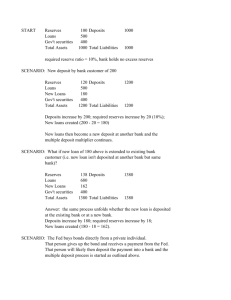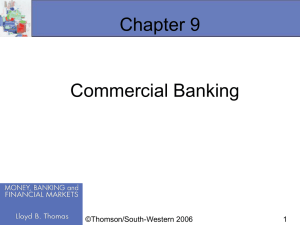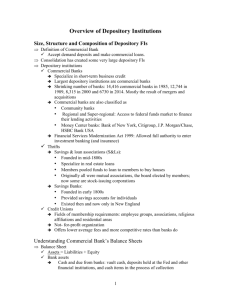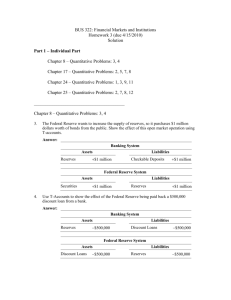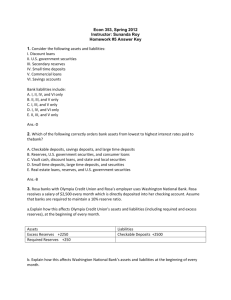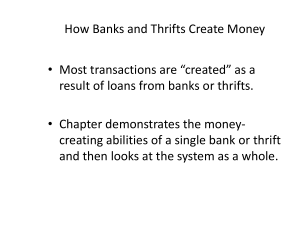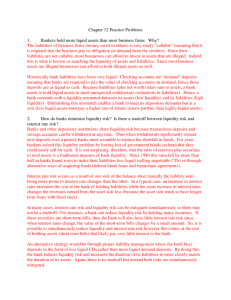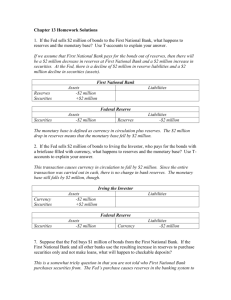Banking - Leeds School of Business
advertisement
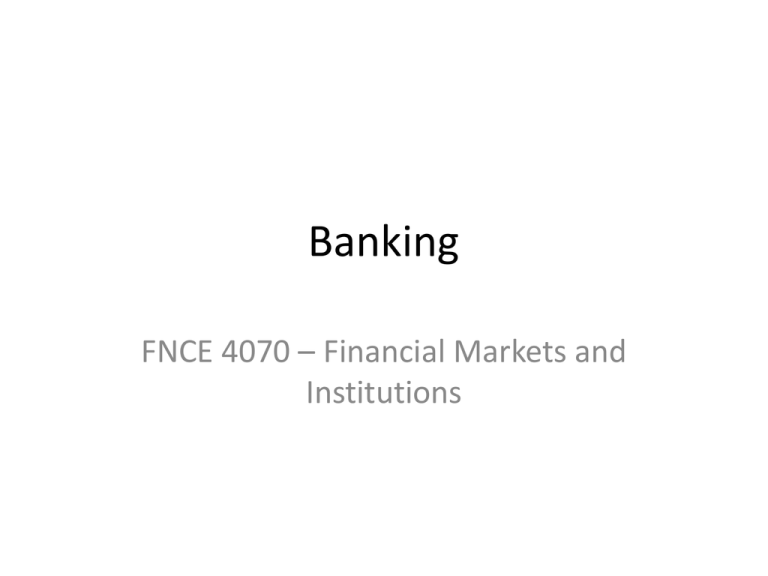
Banking FNCE 4070 – Financial Markets and Institutions The Bank Balance Sheet Flow of funds (tab down to commercial banks) http://www.federalreserve.gov/releases/z1/current/z1r-4.pdf The Bank Balance Sheet: Liabilities (a) • Checkable Deposits: includes all accounts that allow the owner (depositor) to write checks to third parties; examples include non-interest earning checking accounts (known as DDAs— demand deposit accounts), interest earning negotiable orders of withdrawal (NOW) accounts, and money-market deposit accounts (MMDAs), which typically pay the most interest among checkable deposit accounts The Bank Balance Sheet: Liabilities (a) • Checkable deposits are a bank’s lowest cost funds because depositors want safety and liquidity and will accept a lesser interest return from the bank in order to achieve such attributes. They also make up about 4% of bank liabilities. The Bank Balance Sheet: Liabilities (b) • Nontransaction Deposits: are the overall primary source of bank liabilities (74%) and are accounts from which the depositor cannot write checks; examples include savings accounts and time deposits (also known as CDs or certificates of deposit) The Bank Balance Sheet: Liabilities (b) • Nontransaction deposits are generally a bank’s highest cost funds because banks want deposits which are more stable and predictable and will pay more to the depositors (funds suppliers) in order to achieve such attributes. The Bank Balance Sheet: Liabilities (c) • Borrowings: banks obtain funds by borrowing from the Federal Reserve System, other banks, and corporations; these borrowings are called: discount loans/advances (from the Fed), fed funds (from other banks), interbank offshore dollar deposits (from other banks), repurchase agreements (a.k.a., “repos” from other banks and companies), commercial paper and notes (from companies and institutional investors) The Bank Balance Sheet: Liabilities (c) • Certain borrowings can be more volatile than other liabilities, depending on market conditions. They currently make up about 12% of bank liabilities, but have been as high as 26% (2004) and as low as 2% (1960) in recent history. The Bank Balance Sheet: Liabilities (d) • Bank Capital: is the source of funds supplied by the bank owners, either directly through purchase of ownership shares or indirectly through retention of earnings (retained earnings being the portion of funds which are earned as profits but not paid out as ownership dividends). This is about 6% of assets. The Bank Balance Sheet: Liabilities (d) • Since assets minus liabilities equals capital, capital is seen as protecting the liability suppliers from asset devaluations or write-offs (capital is also called the balance sheet’s “shock absorber,” thus capital levels are important). The Bank Balance Sheet: Assets (a) • Reserves: funds held in account with the Fed (vault cash as well). Required reserves represent what is required by law under current required reserve ratios. Any reserves beyond this area called excess reserves. The Bank Balance Sheet: Assets (a) • Cash items in Process of Collection: checks deposited at a bank, but where the funds have not yet been transferred from the other bank. • Deposits at Other Banks: usually deposits from small banks at larger banks (referred to as correspondent banking) The Bank Balance Sheet: Assets (a) • Reserves, Cash items in Process of Collection, and Deposits at Other Banks are collectively referred to as Cash Items in our balance sheet, and account for 2% of assets. The Bank Balance Sheet: Assets (b) • Securities: these are either U.S. government/agency debt, municipal debt, and other (non-equity) securities. These make-up about 17% of assets. Short-term Treasury debt is often referred to as secondary reserves because of its high liquidity. The Bank Balance Sheet: Assets (c) • Loans: representing 74% of assets, these are a bank’s income-earning assets, such as business loans, auto loans, and mortgages. These are generally not very liquid. Most banks tend to specialize in either consumer loans or business loans, and even take that as far as loans to specific groups (such as a particular industry). The Bank Balance Sheet: Assets (d) • Other Assets: bank buildings, computer systems, and other equipment. Principles of Bank Management Liquidity Management Reserves requirement = 10%, Excess reserves = $10 million Principles of Bank Management Deposit outflow of $10 million • With 10% reserve requirement, bank still has excess reserves of $1 million: no changes needed in balance sheet Liquidity Management No excess reserves Deposit outflow of $10 million • With 10% reserve requirement, bank has $9 million reserve shortfall Liquidity Management 1. Borrow from other banks or corporations 2. Sell securities Liquidity Management 3. Borrow from Fed 4. Call in or sell off loans Conclusion: Excess reserves are insurance against above 4 costs from deposit outflows Asset Management • Asset Management: the attempt to earn the highest possible return on assets while minimizing the risk. 1. Get borrowers with low default risk, paying high interest rates 2. Buy securities with high return, low risk 3. Diversify 4. Manage liquidity Liability Management • Liability Management: managing the source of funds, from deposits, to CDs, to other debt. 1. Important since 1960s 2. No longer primarily depend on deposits 3. When see loan opportunities, borrow or issue CDs to acquire funds Capital Adequacy Management 1. Bank capital is a cushion that prevents bank failure. For example, consider these two banks: Capital Adequacy Management What happens if these banks make loans or invest in securities (say, subprime mortgage loans, for example) that end up losing money? Let’s assume both banks lose $5 million from bad loans. Capital Adequacy Management • Impact of $5 million loan loss Conclusion: A bank maintains reserves to lessen the chance that it will become insolvent. Capital Adequacy Management So, why don’t banks hold want to hold a lot of capital?? 2. Higher is bank capital, lower is return on equity ─ ─ ─ ─ ─ ROA = Net Profits/Assets ROE = Net Profits/Equity Capital EM = Assets/Equity Capital ROE = ROA EM Capital , EM , ROE Well-Capitalized Bank • Leverage Ratio – Ratio of Equity to Assets • A bank is classified as well-capitalized if it has a leverage ratio of at least 5%. • A leverage ratio of less than 2% classifies a bank as critically under-capitalzed and the FDIC will take steps to shut it down.
